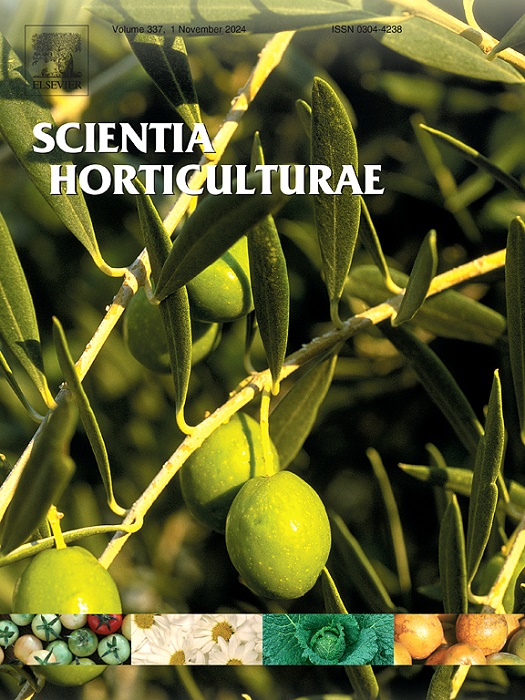Microbial inoculants enhance walnut yield and soil health
IF 3.9
2区 农林科学
Q1 HORTICULTURE
引用次数: 0
Abstract
The walnut industry faces sustainability challenges from declining yield and quality, exacerbated by environmental stressors and soil microbial imbalances. Microbial inoculants can boost crop growth, quality, and stress resistance, but their mechanisms—such as soil modification, pathogen suppression, and microbial community regulation—for enhancing yields require further clarification. In this study, we utilized Illumina MiSeq high-throughput sequencing technology to investigate the effects of conventional chemical fertilizers and microbial agents (Bacillus amyloliquefaciens SDTB009) on disease suppression, soil parameters, microbial communities, as well as walnut yield and quality. The results showed that the implementation of SDTB009 agent as a rhizosphere soil treatment led to notable enhancements in various soil parameters. These included increased levels of soil organic matter, total nitrogen, available potassium, soil microbial biomass carbon and nitrogen, as well as heightened activity of soil urease, alkaline phosphatase, catalase, and sucrase enzymes. Furthermore, the application of SDTB009 promoted the enrichment of Bacillus spp. and Sphingomonas spp., and significantly reduced the abundance of Alternaria spp. and Fusarium spp., concomitantly enhancing walnut yield, quality (the oil content increased by 1.33 %, the total amino acid content increased by 3.58 %, and the total protein content increased by 0.57 %) and fatty acids content. At the same time, it shows that beneficial microorganisms could positively regulate plant growth by improving nutrients and inducing disease resistance signals. This work highlighted the potential of microbial biofertilizers to simultaneously enhance soil health and agroecosystem productivity.

微生物接种剂提高核桃产量和土壤健康
核桃产业面临着产量和质量下降的可持续性挑战,环境压力和土壤微生物失衡加剧了这一挑战。微生物接种剂可以促进作物生长、品质和抗逆性,但其提高产量的机制——如土壤改良、病原体抑制和微生物群落调节——还需要进一步澄清。本研究利用Illumina MiSeq高通量测序技术,研究了常规化肥和微生物制剂(Bacillus olimyquefaciens SDTB009)对核桃病害抑制、土壤参数、微生物群落以及产量和品质的影响。结果表明,施SDTB009剂根际土壤处理可显著提高土壤各项参数。这包括土壤有机质、全氮、速效钾、土壤微生物生物量碳和氮水平的提高,以及土壤脲酶、碱性磷酸酶、过氧化氢酶和蔗糖酶活性的提高。此外,SDTB009的施用促进了芽孢杆菌和鞘氨单胞菌的富集,显著降低了稻孢菌和镰刀菌的丰度,同时提高了核桃的产量、品质(油含量提高1.33%,总氨基酸含量提高3.58%,总蛋白质含量提高0.57%)和脂肪酸含量。同时,说明有益微生物可以通过改善养分、诱导抗病信号等正向调节植物生长。这项工作强调了微生物生物肥料在同时提高土壤健康和农业生态系统生产力方面的潜力。
本文章由计算机程序翻译,如有差异,请以英文原文为准。
求助全文
约1分钟内获得全文
求助全文
来源期刊

Scientia Horticulturae
农林科学-园艺
CiteScore
8.60
自引率
4.70%
发文量
796
审稿时长
47 days
期刊介绍:
Scientia Horticulturae is an international journal publishing research related to horticultural crops. Articles in the journal deal with open or protected production of vegetables, fruits, edible fungi and ornamentals under temperate, subtropical and tropical conditions. Papers in related areas (biochemistry, micropropagation, soil science, plant breeding, plant physiology, phytopathology, etc.) are considered, if they contain information of direct significance to horticulture. Papers on the technical aspects of horticulture (engineering, crop processing, storage, transport etc.) are accepted for publication only if they relate directly to the living product. In the case of plantation crops, those yielding a product that may be used fresh (e.g. tropical vegetables, citrus, bananas, and other fruits) will be considered, while those papers describing the processing of the product (e.g. rubber, tobacco, and quinine) will not. The scope of the journal includes all horticultural crops but does not include speciality crops such as, medicinal crops or forestry crops, such as bamboo. Basic molecular studies without any direct application in horticulture will not be considered for this journal.
 求助内容:
求助内容: 应助结果提醒方式:
应助结果提醒方式:


